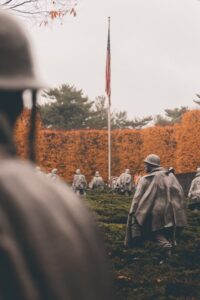14 Wake Forest L. Rev. Online 1
Sam Kiehl[1]*
Introduction
Should an independent school that maintains a § 501(c)(3) tax-exempt status be obligated to comply with Title IX? The answer comes down to how you define “federal financial assistance.”[2] Two recent federal court decisions from opposite ends of the country came out four days apart in July 2022, seeking to address this exact question. The U.S. District Court for the District of Maryland and the U.S. District Court for the Central District of California both expanded Title IX coverage, ruling that independent schools may be subject to Title IX based on maintaining a § 501(c)(3) tax-exempt status.[3] Both courts noted that the United States Supreme Court has never directly addressed whether a tax-exempt status under § 501(c)(3) constitutes federal financial assistance for purposes of Title IX.[4] No federal appellate court has considered the issue either. This Note argues Congress should amend 20 U.S.C. §§ 1681–89 (Title IX) to include a provision that defines “federal financial assistance” and specify that the term includes educational organizations that maintain a tax-exemption. By appropriately distinguishing how “federal financial assistance” is defined, Congress will ensure the judiciary is not operating in a legislative capacity while also fully honoring Title IX’s purpose.
Part I of this Note explores the connection between 26 U.S.C. § 501(c)(3) and 20 U.S.C. §§ 1681–89 and addresses the reasoning for why the Buettner-Hartsoe[5] and E.H. ex rel. Herrera[6] courts concluded that an independent school maintaining a § 501(c)(3) tax-exemption constitutes “federal financial assistance” for purposes of Title IX. Part II analyzes the appellate cases that have further defined the meaning behind terminology used in § 501(c)(3) and Title IX, and it considers several district court cases that have split on whether maintaining a tax-exemption constitutes “federal financial assistance.” Part III reviews scholarly arguments in favor of expanding the public policy doctrine to incorporate Title IX and tax-expenditure theory and ultimately concludes that each argument provides an inadequate or unlikely remedy.
Last, Part IV of this Note argues the Legislature should amend 20 U.S.C. §§ 1681–89 to include a provision which defines “federal financial assistance” and specifies that the term includes educational organizations that maintain a § 501(c)(3) tax-exemption. By doing so, Congress would honor the intent behind Title IX and fulfill the statute’s purpose. In addition, such legislation would prevent the judiciary from legislating by creating a judicial answer to a term not defined by the applicable legislation.
I. Bringing the Issue to Light: Buettner-Hartsoe and E.H. ex rel. Herrera
Both the Buettner-Hartsoe and E.H. ex rel. Herrera cases have brought the relationship between 26 U.S.C. § 501(c)(3) and Title IX to the forefront.[7] The most notable component of Title IX when considering the interplay between the statutes is § 1681(a), which states that “[n]o person in the United States shall, on the basis of sex, be excluded from participation in, be denied the benefit of, or be subjected to discrimination under any education program or activity receiving federal financial assistance . . . .”[8] Neither Congress, the IRS, nor the Supreme Court have provided an exact definition regarding what “federal financial assistance” fully entails. Meanwhile, 26 U.S.C. § 501(c)(3) provides a list of organizations that are exempt from taxation. This list states that any corporation and any community chest, fund, or foundation organized and operated exclusively for the following eight categories qualify for this exemption: (1) religious, (2) charitable, (3) scientific, (4) testing for public safety, (5) literary, (6) educational, (7) foster national or international amateur sports competition, or (8) prevention of cruelty to children or animals.[9] The crux of the issue returns to how “federal financial assistance” is defined under Title IX and whether it includes tax-exemptions under § 501(c)(3).
A. Buettner-Hartsoe v. Baltimore Lutheran High School Association
In Buettner-Hartsoe, the U.S. District Court for the District of Maryland considered five cases brought by separate women against an independent school, all alleging sexual assault and verbal sexual harassment by male students at the school.[10] The plaintiffs brought several of the claims under Title IX.[11] The defendant-school argued it was not subject to Title IX jurisdiction, as it was not a recipient of “federal financial assistance” during the times of the allegations.[12] Ultimately, the court found the defendant’s tax-exempt status maintained under § 501(c)(3) constitutes “federal financial assistance” for the purposes of Title IX, and the court deemed the plaintiffs had viable causes of action.[13]
To support this conclusion, the court first looked at how Title IX’s regulations clarify that a “recipient” under the statute is any entity or person to “whom Federal financial assistance is extended directly or through another recipient and which operates an education program or activity which receives such assistance.”[14] It further noted that neither the Supreme Court nor the Fourth Circuit had directly addressed the issue but provided that key decisions of both courts supported the District Court’s conclusion.[15] The cases that the court relied on involved the following issues: (1) when an entity qualifies as a direct, as opposed to indirect, recipient of “federal financial assistance” for purposes of Title IX;[16] (2) whether an institution must receive federal aid directly for the aid to qualify as “federal financial assistance” under § 501(c)(3);[17] (3) what the purpose and scope of tax-exemptions under § 501(c)(3) are;[18] (4) whether tax-exempt institutions must be in harmony with the public interest;[19] and (5) whether the remedies Congress created in Title IX were modeled after and comparable to those Congress created in Title VI.[20]
Additionally, the court referenced how the Eleventh Circuit had noted in dicta that tax-exemptions qualifying as “federal financial assistance” under Title IX were “neither immaterial nor wholly frivolous.”[21] The court concluded that enforcing the mandates of Title IX in schools with a § 501(c)(3) tax-exempt status aligns with the principal objectives of Title IX, which is to avoid the use of federal resources to support discriminatory practices and to ensure citizens have effective protection against discriminatory practices.[22] It thus found an independent school that maintains a § 501(c)(3) tax-exemption must comply with Title IX requirements.[23]
B. E.H. ex rel. Herrera v. Valley Christian Academy
Meanwhile, in E.H. ex rel. Herrera, the U.S. District Court for the Central District of California heard a suit that involved a female football player at a public high school alleging sex discrimination in violation of Title IX against a private school that refused to play the plaintiff’s football team entirely because of the plaintiff’s gender.[24] The defendant-school argued it did not derive financial assistance from the United States government and thus was not subject to Title IX.[25] The District Court noted that the Ninth Circuit had not addressed whether tax-exempt status confers “federal financial assistance” under Title IX.[26]
The District Court compared two district court cases that had come to opposite conclusions regarding whether tax-exempt status could subject an organization to the requirements of Title IX or Title VI.[27] In a somewhat more conclusory manner than the Buettner-Hartsoe court, the District Court found the “plain purpose of [Title IX] controlling” absent any controlling precedent or legislative history to the contrary.[28] The court noted that because Title IX’s purpose was to eliminate discrimination in programs benefiting from federal financial assistance, the school’s tax-exempt status qualified as “federal financial assistance” and obligated compliance with Title IX.[29]
II. Putting the Pieces Together: Analyzing Appellate and District Level Cases Dealing with Title IX and § 501(c)(3)
While no appellate court has directly addressed whether an educational organization maintaining a § 501(c)(3) tax-exemption must comply with Title IX requirements, there are a number of appellate decisions that address peripheral issues that may be melded together to answer this question. There are also several district level cases prior to Buettner-Hartsoe and E.H. ex rel. Herrera that have addressed the issue head-on.
A. Appellate Cases That Bring Clarity to Title IX and § 501(c)(3)
Grove City College v. Bell[30] is arguably the most vital Supreme Court case to the argument that an independent school maintaining a § 501(c)(3) tax exemption should be obligated to comply with Title IX.[31] In Grove City, the Supreme Court outlined its interpretation of federal financial assistance for civil rights statutory purposes, doing so in the context of defining what an “educational program or activity” is under Title IX.[32] The defendant, Grove City College, argued that neither it nor any education program affiliated with it received federal financial assistance within the meaning of Title IX.[33] Grove City College stated that just because some of its students received Basic Educational Opportunity Grants and used these funds to pay for their education did not alter the fact that it did not receive “federal financial assistance” per Title IX.[34] In Grove City, the Court stated there was no basis in Title IX for the view that only institutions that themselves apply for federal aid or receive checks directly from the federal government are subject to Title IX regulations.[35] The Court confirmed that an institution still qualifies as a recipient of “federal financial assistance” under Title IX even if the institution did not apply for the aid directly.[36] That the government granted the federal funds to Grove City College students rather than directly to one of the college’s educational programs did not preclude Title IX coverage.[37]
National Collegiate Athletic Ass’n v. Smith[38] is the next Supreme Court case that helps define key terms to identify whether a § 501(c)(3) tax-exemption qualifies as federal financial assistance for purposes of Title IX.[39] In this case, the Court defined “recipient” under 34 C.F.R. § 106.2.[40] The Court’s definition of “recipient” makes clear that an entity does not trigger Title IX coverage merely when it benefits from federal funding.[41] The Court stated that this definition is in accordance with Grove City Coll., noting that entities receiving federal financial assistance, whether directly or through an intermediary, are recipients within the meaning of Title IX, but entities that only benefit economically from federal assistance are not.[42]
Meanwhile, in Regan v. Taxation With Representation of Washington,[43] the Supreme Court addressed caveats to the exclusions provided for in 26 U.S.C. § 501(c)(3).[44] The Court ruled the provision in § 501(c)(3) that prohibits tax-exempt status for organizations that seek to influence legislation does not violate the First Amendment.[45] Notable for the argument that a tax-exemption constitutes federal financial assistance for purposes of Title IX, the Court concluded that tax exemptions are a form of subsidy that is administered through the tax system and “has much the same effect as a cash grant to the organization of the amount of tax it would have to pay on its income.”[46]
B. Modeled After Title VI: Title IX, § 504 of the Rehabilitation Act, and the Age Discrimination Act
Understanding “federal financial assistance” as defined in Title IX requires looking beyond the statute and identifying the connection between how the term is used in Title VI, § 504 of the Rehabilitation Act, and the Age Discrimination Act. In Cannon v. University of Chicago[47], the Supreme Court said the principal aim of Title IX was to “avoid the use of federal resources to support discriminatory practices” and “to provide individual citizens effective protection against those practices.”[48] Cannon also noted that Title VI served as a model for Title IX.[49] In coming to this determination, the Court looked to the legislative history and compared the comments of Congress when initially passing Title VI and Title IX.[50] When discussing Title VI, Senator Pastore noted the “purpose of [T]itle VI is to make sure that funds of the United States are not used to support racial discrimination.”[51] When pivoting to the discussion of Title IX, Representative Mink stated that “[a]ny college or university which has [a] … policy which discriminates against women applicants … is free to do so under [Title IX] but such institutions should not be asking the taxpayers of this country to pay for this kind of discrimination.”[52]
The Ninth Circuit noted in Schmitt v. Kaiser Foundation Health Plan of Washington[53] that not only did Title VI serve as a model for Title IX, but it also served as a model for the Age Discrimination Act and the Rehabilitation Act.[54] Accordingly, the court chose to interpret the four statutes similarly.[55] This is crucial, as any argument that states “federal financial assistance” should be defined a certain way regarding Title IX, likely must be able to support “federal financial assistance” being defined in the same manner when interpreting Title VI, § 504 of the Rehabilitation Act, and the Age Discrimination Act. The argument thus becomes significantly more expansive, and there are more potential pitfalls for a court or legislature seeking to define “federal financial assistance” in an overly broad manner.
When considering the importance of the connection between Title VI and Title IX, it becomes necessary to consider the public policy doctrine created by the Supreme Court in Bob Jones University v. United States.[56] Bob Jones was a significant case where the Supreme Court expanded the requirements that must be met to obtain tax-exempt charitable status by holding that a charitable organization may not violate “established public policy.”[57] In Bob Jones, the university was denied tax-exempt status because of its racially discriminatory admissions policy, and the university argued the practice was legal because it was based on religious doctrine.[58] The Court created the public policy doctrine, which supported the IRS’ argument that § 501(c)(3) implied that tax-exempt institutions had to meet common law definitions for charitable trusts, meaning they had to provide a public benefit and not be opposed to fundamental public policy.[59]
However, despite the creation of the public policy doctrine, the doctrine has not provided a significant amount of bite since the Court enacted it. Seventeen years later, in FDA v. Brown & Williamson Tobacco Corp.,[60] the Court noted that no matter how important an issue is, “an administrative agency’s power to regulate in the public interest must always be grounded in a valid grant of authority from Congress.”[61] This points to why the courts have not already used the public policy doctrine to incorporate Title IX. The Court noted that though it sought to effectuate the congressional purpose of protecting citizens as Title IX called for, it wanted to be cautious so as not to extend the scope of the statute beyond the intended parameters originally determined by Congress.[62]
Taking all the curated appellate court cases into consideration, no federal appellate court has directly considered whether an organization maintaining a tax-exempt status constitutes “federal financial assistance” for purposes of Title IX. However, the Eleventh Circuit has considered the issue most closely, as it provided in dicta in M.H.D. v. Westminster School[63] that allegations regarding an organization maintaining a tax-exempt status qualifies as “federal financial assistance” under Title IX provisions were “neither immaterial nor wholly frivolous.”[64] This is the most notable statement in support of the assertion that tax-exempt status under § 501(c)(3) qualifies as “federal financial assistance” under Title IX provisions from a United States federal appellate court. And though no appellate court has directly considered whether an organization maintaining a tax-exempt status constitutes “federal financial assistance” for purposes of Title IX, several district courts, besides the two most recent decisions, have either directly or peripherally considered the issue over the last forty years.
C. District Courts Addressing the Combined Issues of Title IX and § 501(c)(3)
In Fulani v. League of Women Voters Education Fund,[65] the Southern District of New York considered a suit brought by minor-party candidates alleging that, among other issues, they were excluded from debates sponsored by a nonprofit organization based on race and sex discrimination.[66] The court noted the entity was subject to Title VI and Title IX enforcement because it “receive[d] federal assistance indirectly through its tax exemption and directly through grants” from federal agencies.[67] In McGlotten v. Connally,[68] the District Court for the District of Columbia heard a suit brought by a black-American to enjoin the Secretary of Treasury from granting tax benefits to organizations that exclude non-whites from membership.[69] The D.C. Circuit considered whether tax benefits meet the definition of “federal financial assistance” within the terms of Title VI of the Civil Rights Act and whether Congress had clearly indicated that beneficiaries of tax-exemptions should not discriminate.[70] The court looked to how 42 U.S.C. § 2000d-1 defines “federal financial assistance” and ultimately held that tax-exemptions constitute “federal financial assistance” in the context of Title VI litigation.[71] Though the court noted nothing in the “massive legislative history” of the 1964 Civil Rights Act that indicated whether assistance provided through the tax system was intended to be treated differently than assistance provided directly, it deemed the plain purpose of Title VI controlling.[72] It stated that the statute’s plain purpose was to eliminate discrimination in programs benefitting from federal financial assistance.[73]
Meanwhile, Johnny’s Icehouse, Inc. v. Amateur Hockey Ass’n Illinois, Inc.[74] is the most recent district court case where the court concluded that an organization maintaining a § 501(c)(3) tax-exemption did not constitute a form of “federal financial assistance” and thus did not obligate the organization to comply with Title IX regulations.[75] The court’s reasoning centered on observations that income tax exemptions are “conspicuously absent” from the “laundry list” of Title IX regulations that define federal financial assistance.[76] However, this case is over twenty years old, and both the Buettner-Hartsoe and E.H. ex rel. Herrera courts found the court’s reasoning in Johnny’s Icehouse, Inc. unconvincing.[77] Bachman v. American Society of Clinical Pathologists[78] is an even earlier district court case where the court also found that tax benefits do not constitute “federal financial assistance” as defined in Title IX.[79] The court stated that only direct grants could qualify as federal financial assistance.[80] However, the Supreme Court rebuffed this line of reasoning a year later in Grove City College, which is notable because of the potential similarity between Title IX and § 504 of the Rehabilitation Act. Martin v. Delaware Law School of Widener University[81] is another district court case that goes against the proposition that a tax-exemption under § 501(c)(3) can constitute “federal financial assistance” in the context of the Rehabilitation Act.[82]
When viewing the aggregated appellate decisions that serve as building blocks for answering this question, as well as the inconsistent decisions that district courts have come to, it appears the issue is ripe for consideration by the courts. However, as indicated by courts noting the similarities between Title IX, Title VI, § 504 of the Rehabilitation Act, and the Age Discrimination Act, whatever decision a court comes to has broad implications beyond simply how “federal financial assistance” is defined in relation to Title IX.
III. Inadequate and Unlikely Remedies: The Public Policy Doctrine and Tax-Expenditure Theory
Up to this point, courts and scholars have sought to better hold organizations accountable for anti-discrimination regarding race and sex when the organization maintains tax-exemption but does not otherwise receive federal funding. The most successful example has been the ruling by the Supreme Court in Bob Jones with the creation of the public policy doctrine.[83] Other notable attempts by scholars have included using tax-expenditure theory to support the reasoning for why tax-exempt charities receive “federal financial assistance” based on their favored tax status and thus should comply with civil rights laws.[84] However, concerns exist that these remedies are either inadequate or unlikely.
A. Critique of the Public Policy Doctrine as an Effective Tool
In Bob Jones, the Supreme Court expanded requirements for tax-exempt charitable status under § 501(c)(3) by holding that a charitable organization cannot violate “established public policy,” despite the fact that this limitation was not set out in the Internal Revenue Code.[85] Though the Court stated that violation of public policy, like discriminatory admission policies based on race, must be “established,” it did not provide clear boundaries for how to determine when a policy other than discrimination based on race is sufficiently established.[86] A number of arguments can be made by different parties, all of them equally advocating that public policy is offended by a certain issue. The reality is that the lack of parameters means it is unlikely a court will enforce any of them. The substantial gridlock in Washington, D.C. that comes from an increasingly polarizing political atmosphere makes it incredibly unlikely that the Supreme Court would use the public policy doctrine to issue blanket statements that certain actions and policies violate public policy.
The public policy limitation on charities did not initially come from the judiciary or legislature but instead came from the Treasury in a 1970 News Release.[87] This release indicated that the IRS could not legally justify providing a tax-exempt status based on the charitable exception in § 501(c)(3) to organizations that practice racially discriminatory practices.[88] The IRS justified its position by relying on what it found were clearly established federal policies against racial discrimination in education as outlined in Brown v. Board of Education[89] and further expanded on in the Civil Rights Act of 1964.[90] It was this policy that the Supreme Court later approved by creating the public policy doctrine in Bob Jones.[91] However, soon after, the Supreme Court indicated that the lack of set boundaries is an issue when considering whether an action falls under the public policy doctrine in FDA v. Brown & Williamson Tobacco Corp.[92] The Brown & Williamson Tobacco Corp. decision supports the argument that the Court is not going to expand the public policy doctrine further because no matter how important and controversial an issue is, the Court likely believes the Legislative branch should be creating legislation instead of the judiciary.
Since the public policy doctrine came from a Treasury News Release, later adopted by the Supreme Court, and did not come directly from the Legislature, using the public policy doctrine to incorporate an organization’s tax-exempt status to constitute “federal financial assistance” for the purposes of Title IX would likely be seen as extending the scope of the statute beyond the point where Congress indicated it should reach. Though the statement that sex discrimination is against public policy seems rational enough, the nuances of Title IX and how it applies to educational entities, including parochial schools in certain situations, means it is unlikely the Supreme Court today would find the public policy doctrine an appropriate avenue to enforce independent schools to maintain a § 501(c)(3) tax-exemption to comply with Title IX requirements. Especially as divisive as society is today, arguing for the expansion of the public policy doctrine to serve as a remedy for this issue is inadequate and unlikely to gain traction in Congress or with the public.
B. Critique of Tax-Expenditure Theory as an Effective Tool
Another remedy that has been proposed, this time primarily by academics as opposed to by courts or agencies, is for courts to apply tax-expenditure theory to determine whether tax-exempt organizations should be obligated to comply with anti-discrimination laws due to being recipients of government financial assistance.[93] Tax-expenditures are alternative policy means by which governments deliver financial support to individuals and companies.[94] The primary question addressed by tax-expenditure theory is whether the receipt of a tax benefit should be legally regarded as equivalent to a direct government grant of money.[95] It is possible to interpret tax-expenditure theory to posture that an organization’s § 501(c)(3) tax-exemption is the equivalent of a cash subsidy from the government. Though this notably only applies when an organization seeks to advocate for or implement social policy by using tax benefits and not when an organization uses a tax-exemption simply as a “further delineation of the appropriate tax base.”[96]
Ultimately, while this certainly is a viable option, it is unlikely to be successful. The primary concern is that while tax expenditure theory relies on current civil rights laws to address discrimination in charitable organizations in a broad manner, doing so based on the current legislation will only address some forms of discrimination but not others.[97] Of course, such legislation would protect individuals against discrimination on the basis of race, sex, gender, national origin, religion, and disability. But there are certain forms of discrimination in charitable organizations that use a § 501(c)(3) tax-exemption status that would not be protected, such as sexual orientation.[98] The use of tax expenditure theory becomes too broad of a tool and, in doing so, becomes a less effective tool in addressing discriminatory practices by organizations that maintain a § 501(c)(3) tax-exemption.
IV. Amendment of 20 U.S.C. § 1681 to Define Federal Financial Assistance
Due to the limitations of the proposed remedies listed above, it seems the most effective solution to addressing whether independent schools that maintain a § 501(c)(3) tax-exemption should be obligated to comply with Title IX is to amend Title IX to include a provision that defines “federal financial assistance” and specifies inclusion of educational entities that maintain a tax-exemption in the definition. This would further help differentiate how “federal financial assistance” is defined under Title VI, § 504 of the Rehabilitation Act, and the Age Discrimination Act and why that definition should not have a direct bearing on how “federal financial assistance” is defined under Title IX. In doing so, this would eliminate concerns of the judiciary essentially creating legislation by applying “federal financial assistance” differently within the context of Title IX compared to Title VI, § 504 of the Rehabilitation Act, and the Age Discrimination Act. Most importantly, it would ensure that Congress and the courts honor Title IX’s purpose.
As stated above, in several cases the Supreme Court has attempted to clarify vagueness brought upon by the use of the phrase “federal financial assistance” in the first sentence of Title IX, § 1681(a), which says “[n]o person in the United States shall, on the basis of sex . . . be subjected to discrimination under any education program or activity receiving federal financial assistance . . . .” However, a murky understanding of the term remains. To amplify the problem, when attempting to define the term “federal financial assistance” specific to Title IX, one must look at how Congressional records show that Title IX was modeled after Title VI and is comparable to how the term is also used in § 504 of the Rehabilitation Act and the Age Discrimination Act.
In light of these problems, the most comprehensive solution is for Congress to amend Title IX to include a definition of “federal financial assistance.” This definition should be based on an understanding of the currently existing definition of “federal financial assistance” as provided for by the Supreme Court in Grove City, National Collegiate Athletic Ass’n v. Smith, and Cannon v. University of Chicago.[99] In addition, the definition should effectively mirror the plain purpose of Title IX, which is to ensure the removal of barriers that prevent people on the basis of sex from participating in educational opportunities of their choice. Congress could accomplish this via an amendment that adds a paragraph to Title IX following 20 U.S.C. § 1681(c), which defines “educational institution.” Said paragraph should be similar to the following:
For purposes of this chapter, federal financial assistance may include:
(1) A grant or loan of federal financial assistance, including funds made available for:
- The acquisition, construction, renovation, restoration, or repair of a building or facility or any portion thereof; and
- Scholarships, loans, grants, wages, or other funds extended to any entity for payment to or on behalf of students admitted to that entity, or extended directly to such students for payment to that entity.
(2) A grant of Federal real or personal property or any interest therein, including surplus property, and the proceeds of the sale or transfer of such property, if the Federal share of the fair market value of the property is not, upon such sale or transfer, properly accounted for to the Federal Government.
(3) Any other contract agreement or arrangement that has as one of its purposes the provision of assistance to any education program or activity, except a contract of insurance or guaranty.
(4) A grant or loan that is received directly or indirectly, even if an entity does not show a financial gain, in the sense of a net increment in its assets.
(5) A tax-exemption maintained by educational organizations under 26 U.S.C. § 501(c)(3).
(6) However, federal financial assistance does not include:
- A simple assertion that an entity receives something of value in nonmonetary form from the federal government’s presence or operations;
- Statutory programs or regulations that directly or indirectly support, or establish guidelines for, an entity’s operations;
- Programs owned and operated by the federal government; or
- Direct, unconditional assistance to ultimate beneficiaries, the intended class of private citizens receiving federal aid, such as social security payments and veterans pensions.[100]
A statutory amendment to define “federal financial assistance” will further Congressional intent regarding Title IX. As it stands now, independent schools may have the prerogative, as evidenced by the schools in Buettner-Hartsoe and E.H. ex rel. Herrera, to attempt to disregard what Title IX seeks to prevent: discrimination on the basis of sex.[101] This proposed amendment closes a loophole that independent schools may seek to exploit. It prevents schools that receive significant and tangible benefits by maintaining tax-exempt status under § 501(c)(3) from supporting discriminatory practices in education and also provides a broader base of individual citizens’ protection against those practices.
Notably, such an amendment does not impact parochial schools the same way it would impact independent schools that maintain a tax-exemption under § 501(c)(3). Educational institutions controlled by a religious organization are exempt from Title IX to the extent that the application of Title IX would be inconsistent with the organization’s religious tenets.[102] Thus, when categorizing independent schools, it is important to understand that an amendment would only impact independent schools, such as charter schools which may not receive public funds but that maintain a § 501(c)(3) tax-exemption; it would not impact parochial schools that already have certain exemptions provided for in 20 U.S.C. § 1681(a)(3).
Additionally, a benefit to amending Title IX as opposed to 26 U.S.C. § 501(c)(3) is that the charitable exemption exception contained in that statute includes a wide variety of organizations beyond just those organized for educational purposes. These include organizations operated for religious, charitable, scientific, testing for public safety, or literary purposes, as well as those that seek to foster national or international amateur sports competitions or that are designed to prevent cruelty to children or animals.[103] Amending § 501(c)(3) to remedy the issue of tax-exempt independent schools discriminating on the basis of sex would lead to questions of Title IX’s applicability outside of the educational context. Furthermore, even if Congress were to amend § 501(c)(3), there would still be ambiguity when it comes to how to define “federal financial assistance.” It would also not answer the question of if and how to differentiate how “federal financial assistance” is defined in Title IX compared to Title VI, § 504 of the Rehabilitation Act, and the Age Discrimination Act.
Some district courts have not quite comprehended the magnitude of a decision to determine that an organization maintaining a tax-exemption constitutes “federal financial assistance” for purposes of Title IX. Doing so not only requires organizations to abide by Title IX requirements, but also would likely lead to an expansion of such organizations having to abide by Title VI, § 504 of the Rehabilitation Act, and the Age Discrimination Act.[104] Title VI of the Civil Rights Act of 1964 and Title IX of the Education Amendments Act of 1972 are the principal laws that forbid discrimination based on race and sex, respectively, by private actors that receive federal financial assistance. Both statutes condition federal funding on the promise that the recipient of the funds will not discriminate. Title VI, which the other statutes were modeled after, states that “[e]ach Federal department and agency which is empowered to extend Federal financial assistance . . . is authorized and directed to effectuate . . . this title . . . by issuing rules, regulations, or orders . . . which shall be consistent with achievement of the objectives of the statute authorizing the financial assistance in connection with which the action is taken.”[105] Section 1682 of Title IX almost repeats this definition word-for-word.
The Rehabilitation Act of 1973 and the Age Discrimination Act also impose civil rights restrictions based on a private actor’s receipt of federal financial assistance.[106] § 504 of the Rehabilitation Act was also modeled specifically after Title VI and may also provide guidance when analyzing Title IX.[107] However, Title IX, unlike Title VI, § 504 of the Rehabilitation Act, and the Age Discrimination Act, only applies to educational entities such as colleges, universities, elementary and secondary schools, as well as any educational or training program operated by a recipient of federal financial assistance.[108] Each of the other statutes applies in a significantly broader manner.
Thus, the parallel nature of each of the statutes lends to a similar, if not the exact same, analytical framework being used when applied to cases under all four statutes. However, this limits each of the statutes because how “federal financial assistance” is defined in one statute then must be used in a similar manner in the other three statutes. This lack of flexibility can cut against each of the statutes in different ways. For instance, while Title VI covers employment only in limited circumstances, employment discrimination is clearly covered in Title IX.[109] Meanwhile, holding that “federal financial assistance” applies to all institutions maintaining a § 501(c)(3) tax-exemption, while appropriately applicable to educational organizations, cuts in an overly broad manner when applied to the Title VI, § 504 of the Rehabilitation Act, and the Age Discrimination Act. Defining the term in such a way could be especially harmful to employers that must comply with § 504 of the Rehabilitation Act and the Age Discrimination Act. This would subject employers to additional regulations that they have arguably sought to avoid by not accepting federal financial assistance, notwithstanding maintaining a tax-exemption. It also would be less likely to receive support in Congress as such an expansive definition would have considerable detractors that prefer less governmental interference in the free market.
The legislative history behind Title IX is also significant in showing that it is reasonable to believe Congress intended for there to be a distinction in how “federal financial assistance” applies in the context of Title IX compared to Title VI, § 504 of the Rehabilitation Act, and the Age Discrimination Act. Congress designed Title IX specifically with schools and educational programs in mind. The statute initially came to life in Congress when Senator Bayh of Indiana introduced an amendment with the purpose of combating the “continuation of corrosive and unjustified discrimination against women in the American educational system.”[110] This distinction is nowhere to be found in the other three statutes, as Title IX is the only statute of the four that is siloed off and applies specifically to discriminatory practices within education programs. Since the purpose of Title IX, as supported by the legislative history, is to eliminate discrimination on the basis of sex in education programs, specifying how “federal financial assistance” is defined in Title IX in contrast to how it is defined in Title VI, § 504 of the Rehabilitation Act, and the Age Discrimination Act is appropriate in working towards achieving this goal.
Conclusion
Independent schools that choose to enjoy the benefits of a § 501(c)(3) tax-exemption should be obligated to comply with Title IX. However, a current gap exists in how “federal financial assistance” is defined under Title IX and if that same phrase should be defined similarly or differently when comparing Title IX with Title VI, § 504 of the Rehabilitation Act, and the Age Discrimination Act. This gap makes it unclear whether Title IX applies to § 501(c)(3) organizations. Whether Title IX applies to those organizations has been considered peripherally by several appellate courts and directly by a number of district courts over the past forty years. To clarify that independent schools that maintain a tax-exemption should be obligated to comply with Title IX, the courts or legislature must clarify: (1) when an entity qualifies as a recipient of “federal financial assistance;” (2) whether the definition of “federal financial assistance” applies differently across Title IX, Title VI, § 504 of the Rehabilitation Act, and the Age Discrimination Act; (3) what the purpose and scope of tax-exemptions under § 501(c)(3) are; and (4) whether Title IX, as it exists now, is fully accomplishing the purpose Congress set out for it to accomplish.
The most effective and comprehensive way to address this issue is for the Legislature to amend 20 U.S.C. §§ 1681–89 to include a provision that defines “federal financial assistance” and specifies including educational entities that maintain a tax-exemption. Such an amendment would faithfully fulfill Title IX’s purpose to ensure avoidance of the use of federal funds in aiding educational programs that support discriminatory practices based on sex and protect individuals against those discriminatory practices. Doing so would also provide clarity to both the courts and organizations on how to distinguish “federal financial assistance” as it is defined in Title IX as opposed to how it is defined in Title VI, § 504 of the Rehabilitation Act, and the Age Discrimination Act.
Furthermore, an amendment to Title IX by Congress would also save the judiciary from being put in a place where it is essentially being asked to legislate by finding a judicial answer to the question of whether maintaining a tax-exemption qualifies an educational organization as receiving “federal financial assistance” per Title IX. Up to this point, the Supreme Court has already had to interpret what Congress meant regarding the definition of “federal financial assistance” for civil rights statutory purposes in Grove City College, and the definition of “recipient” for purposes of 34 C.F.R. § 106.2 in National Collegiate Athletic Ass’n. The fact that a number of district courts in the time since the Supreme Court decided Grove City College and National Collegiate Athletic Ass’n have had to attempt to address whether an independent educational program that maintains a § 501(c)(3) tax-exemption is obligated to comply with Title IX means this is an issue still needing clarification. If Congress does not address the issue, it is that much more likely that courts will again be put into the position of having to determine what Congress’s intent was when drafting Title IX and whether it should apply to independent schools that maintain a § 501(c)(3) tax-exemption but receive no other form of federal financial assistance.
When first advocating for the adoption of Title IX, Senator Bayh sought to fight against the “sex discrimination that reaches into all facets of education,” and it was for this reason that Congress enacted Title IX.[111] The amendment of Title IX to define “federal financial assistance” to include independent educational entities that maintain a § 501(c)(3) tax-exemption and to obligate compliance with the statute furthers the goal of eliminating discrimination on the basis of sex in the field of education while providing continued protections for individuals in education.
- *. Third-year law student at the Wake Forest University School of Law. B.S. in Social Studies Education from the University of Oklahoma and will begin practicing with Conner & Winters, LLP in their Tulsa office following graduation. Many thanks to Dylan, Keegan, and the team at the Wake Forest Law Review Online for their partnership on this article. I am also forever grateful to my parents for encouraging my love of learning at my own pace, to Rob and Carilyn for fostering my connection with the law, and, most importantly, to Dr. Robin Rainey Kiehl for being the ultimate teammate, wife, and soon-to-be mother. ↑
- . 20 U.S.C.A. § 1681(a) (West). ↑
- . See Buettner-Hartsoe v. Balt. Lutheran High Sch. Ass’n, No. CV RDB-20-3132, 2022 WL 2869041 at *5 (D. Md. July 21, 2022), motion to certify appeal granted, No. CV RDB-20-3132, 2022 WL 4080294 (D. Md. Sept. 6, 2022); E.H. ex rel. Herrera v. Valley Christian Acad., 616 F. Supp. 3d 1040, 1049–50 (C.D. Cal. 2022). ↑
- . See Buettner-Hartsoe, 2022 WL 2869041, at *3; E.H. ex rel. Herrera, 616 F. Supp. 3d at 1049–50. ↑
- . Buettner-Hartsoe, 2022 WL 2869041. ↑
- . E.H. ex rel. Herrera, 616 F. Supp. 3d 1040. ↑
- . See id.; Buettner-Hartsoe, 2022 WL 2869041. ↑
- . 20 U.S.C.A. § 1681(a) (West). ↑
- . 26 U.S.C.A. § 501(c)(3) (West). ↑
- . Buettner-Hartsoe, 2022 WL 2869041, at *1. ↑
- . Id. ↑
- . Id. ↑
- . Id. ↑
- . Id. at *3 (referencing 34 C.F.R. § 106.2(i) (2023)). ↑
- . Id. ↑
- . Grove City Coll. v. Bell, 465 U.S. 555, 569–70 (1984). ↑
- . Nat’l Collegiate Athletic Ass’n v. Smith, 525 U.S. 459, 468–69 (1999). ↑
- . Regan v. Tax’n With Representation, 461 U.S. 540, 550–51 (1983). ↑
- . Bob Jones Univ. v. United States, 461 U.S. 574, 591–92 (1983). ↑
- . Cannon v. Univ. of Chi., 441 U.S. 667, 694–96 (1979). ↑
- . M.H.D. v. Westminster Schs., 172 F.3d 797, 802 n.12 (11th Cir. 1999). ↑
- . Buettner-Hartsoe v. Balt. Lutheran High Sch. Ass’n, No. RDB-20-3132, 2022 WL 2869041, at *5 (D. Md. July 21, 2022) (quoting Cannon, 441 U.S. at 704). ↑
- . Id. at *3. The court subsequently granted the school district’s motion for interlocutory appeal to the United States Court of Appeals for the Fourth Circuit to consider the issue of whether § 501(c)(3) tax-exempt status constitutes federal financial assistance under Title IX. See Buettner-Hartsoe, 2022 WL 4080294, at *1. The parties are currently in the pretrial stage of litigation regarding this interlocutory appeal. ↑
- . E.H. ex rel. Herrera v. Valley Christian Acad., 616 F. Supp. 3d 1040, 1044 (C.D. Cal. 2022). ↑
- . Id. at 1048–49. ↑
- . Id. at 1050. ↑
- . Id. (comparing Johnny’s Icehouse, Inc. v. Amateur Hockey Ass’n, 134 F. Supp. 2d 965, 972 (N.D. Ill. 2001) and McGlotten v. Connally, 338 F. Supp. 448, 461 (D.D.C. 1972)). ↑
- . Id. ↑
- . Id. ↑
- . Grove City Coll. v. Bell, 465 U.S. 555 (1984). ↑
- . Id. at 574–75. ↑
- . Id. at 557. ↑
- . Id. at 563. ↑
- . Id. ↑
- . Id. at 564. ↑
- . Id. at 569–70. ↑
- . Id. ↑
- . Nat’l Collegiate Athletic Ass’n v. Smith, 525 U.S. 459 (1999). ↑
- . Id. at 462. ↑
- . Id. at 460. Part 106 of Title 34 of the Code of Federal Regulations contains regulations promulgated by the Office of Civil Rights within the Department of Education that concern nondiscrimination on the basis of sex in education programs or activities receiving federal financial assistance. ↑
- . Id. ↑
- . Id. at 460–61. The Court attempted to clarify where this line was drawn by noting that an entity does not open itself to Title IX obligations on the grounds it receives dues from its members, which receive federal financial assistance if the members do not earmark federal funds for the purpose of paying dues. ↑
- . 461 U.S. 540 (1983). ↑
- . Id. at 540. ↑
- . Id. ↑
- . Id. at 544. ↑
- . 441 U.S. 677 (1979). ↑
- . Id. at 704. ↑
- . Id. ↑
- . Id. at 704 n.6. ↑
- . Id. (referencing 110 Cong. Rec. 7062 (1964)). ↑
- . Id. (referencing 117 Cong. Rec. 39252 (1971)). ↑
- . 965 F.3d 945 (9th Cir. 2020). ↑
- . Id. at 953. ↑
- . Id. ↑
- . 461 U.S. 574, 603–04 (1983). ↑
- . Id. at 591. ↑
- . Id. at 577. ↑
- . Id. at 579. ↑
- . 529 U.S. 120 (2000). ↑
- . Id. at 161. ↑
- . Id. ↑
- . 172 F.3d 797 (11th Cir. 1999). ↑
- . Id. at 802 n.12. ↑
- . 684 F. Supp. 1185 (S.D.N.Y. 1988). ↑
- . Id. at 1186–87. ↑
- . Id. at 1192. ↑
- . 338 F. Supp. 448 (D.D.C. 1972). ↑
- . Id. at 450. ↑
- . Id. at 460. ↑
- . Id. at 461. ↑
- . Id. ↑
- . Id. ↑
- . 134 F. Supp. 2d 965 (N.D. Ill. 2001). ↑
- . Id. at 972. ↑
- . Id. at 971. ↑
- . Buettner-Hartsoe v. Balt. Lutheran High Sch. Ass’n, No. CV RDB-20-3132, 2022 WL 2869041 at *5 (D. Md. July 21, 2022); E.H. ex rel. Herrera v. Valley Christian Acad., 616 F. Supp. 3d 1040, 1049–50 (C.D. Cal. 2022). ↑
- . 577 F. Supp. 1257 (D.N.J. 1983). ↑
- . Id. at 1264–65. ↑
- . Id. ↑
- . 625 F. Supp. 1288 (D. Del. 1985). ↑
- . Id. at 1298. ↑
- . Bob Jones Univ. v. United States, 461 U.S. 574, 586 (1983). ↑
- . David A. Brennen, Tax Expenditures, Social Justice, and Civil Rights: Expanding the Scope of Civil Rights Laws to Apply to Tax-Exempt Charities, 2001 B.Y.U. L. Rev. 167, 206–07 (2001). ↑
- . Bob Jones Univ., 461 U.S. at 601–02. ↑
- . Id. ↑
- . Brennen, supra note 83, at 183 (citing I.R.S. News Release (July 10 1970), reprinted in 7 Stand. Fed. Tax Rep. (CCH) ¶ 6,790). ↑
- . Id. ↑
- . 347 U.S. 483, 495 (1954). ↑
- . 2000 EO CPE Text, Private School Update, at 187. ↑
- . Bob Jones Univ., 461 U.S. at 605. ↑
- . 529 U.S. 120, 161 (2000). ↑
- . Brennen, supra note 83, at 191–92. ↑
- . IMF, Tax Expenditure Reporting and Its Use in Fiscal Management: A Guide for Developing Economies, Fiscal Affairs Department (Mar. 2019). ↑
- . Nicholas A. Mirkay, Is It “Charitable” to Discriminate?: The Necessary Transformation of Section 501(c)(3) into the Gold Standard for Charities, 2007 Wis. L. Rev. 45, 80 (2007). ↑
- . Id. at 80–81. ↑
- . Id. at 66, 68. ↑
- . Id. at 68. ↑
- . Grove City Coll. v. Bell, 465 U.S. 555, 569 (1984); Nat’l Collegiate Athletic Ass’n v. Smith, 525 U.S. 459, 466–67 (1999); Cannon v. Univ. of Chi., 441 U.S. 677, 704 (1979). ↑
- . 20 U.S.C. §§ 1681(c); U.S. Dep’t of Just., Title IX Legal Manual § III(A)(1) (2021) (modeled off of discussion of the scope of coverage in the Title IX manual regarding federal financial assistance). ↑
- . Buettner-Hartsoe v. Balt. Lutheran High Sch. Ass’n, No. CV RDB-20-3132, 2022 WL 2869041 at *5 (D. Md. July 21, 2022), motion to certify appeal granted, No. CV RDB-20-3132, 2022 WL 4080294 (D. Md. Sept. 6, 2022); E.H. ex rel. v. Valley Christian Acad., 616 F. Supp. 3d 1040, 1049–50 (C.D. Cal. 2022). ↑
- . 20 U.S.C. §§ 1681(a)(3); 34 C.F.R. § 106.12(a) (2020). ↑
- . 26 U.S.C.A. § 501(c)(3) (West). ↑
- . Mirkay, supra note 94, at 75 n.176. ↑
- . 42 U.S.C. § 2000d-1. ↑
- . Brennen, supra note 83, at 192. ↑
- . Alexander v. Choate, 469 U.S. 287, 294 (1985). ↑
- . 20 U.S.C.A. § 1681 (West). ↑
- . See 20 U.S.C. §§ 1681–89; U.S. Dep’t of Just., Title IX Legal Manual § I (2021). ↑
- . 118 Cong. Rec. 5803 (1972) (statement of Sen. Bayh). ↑
- . Id. ↑












